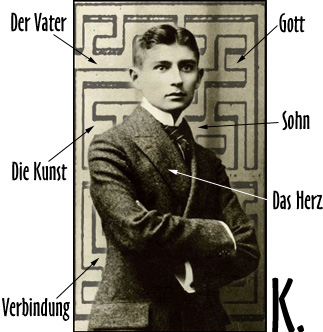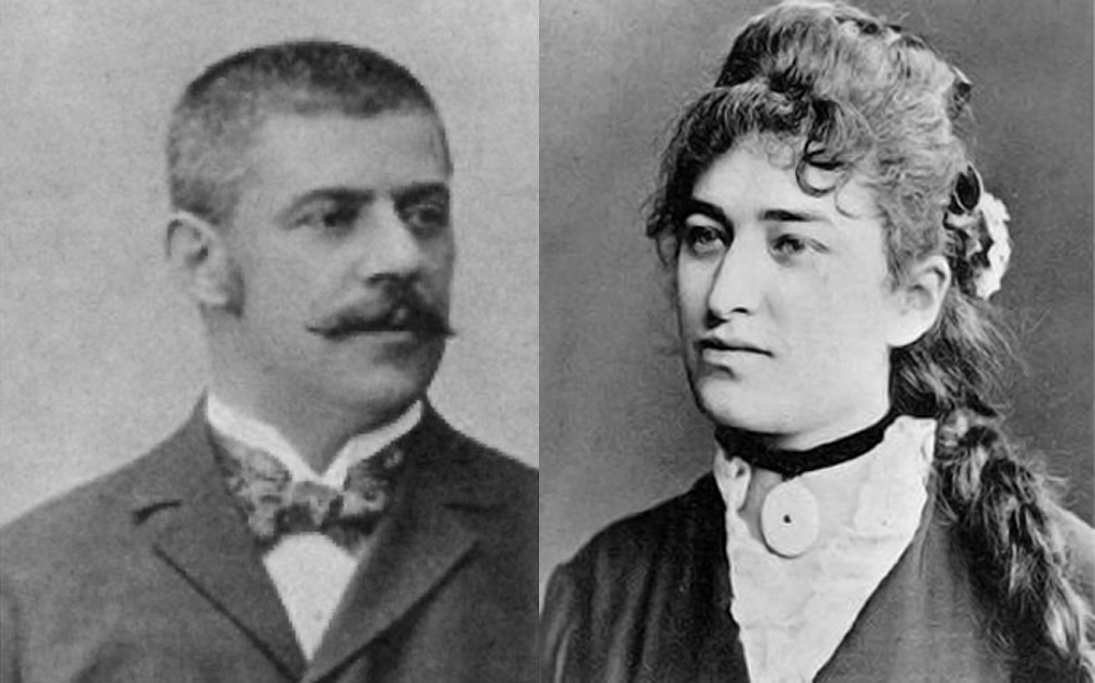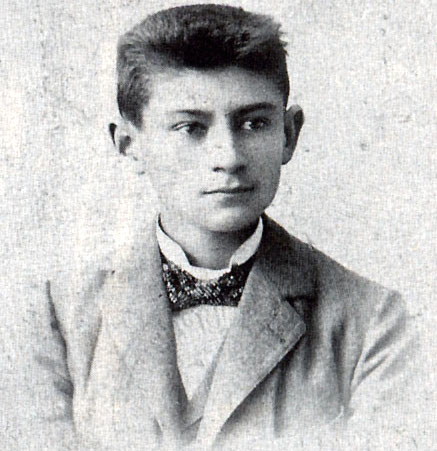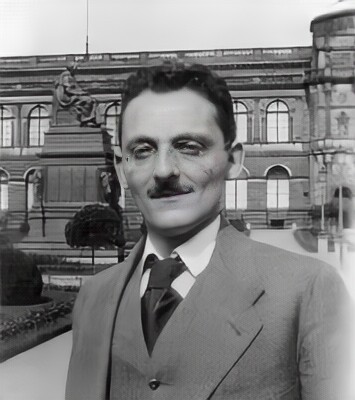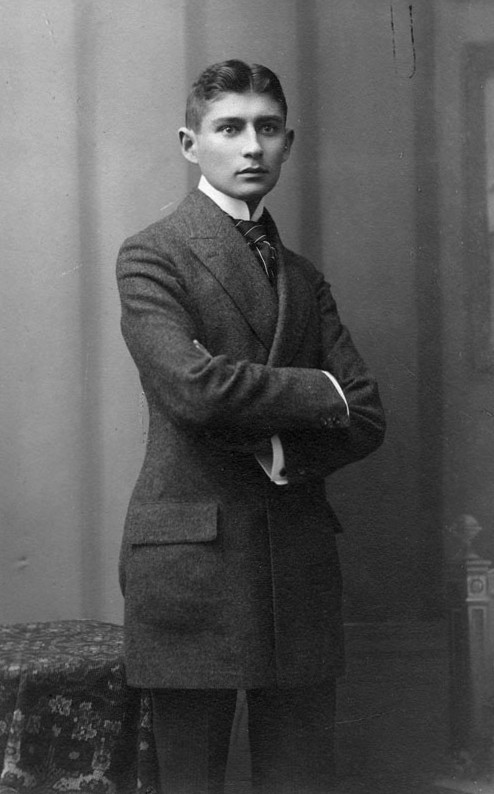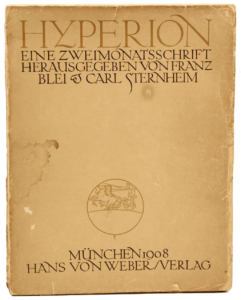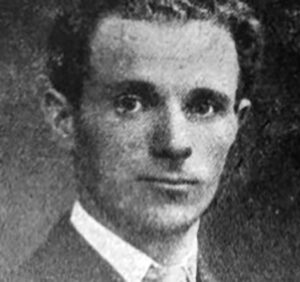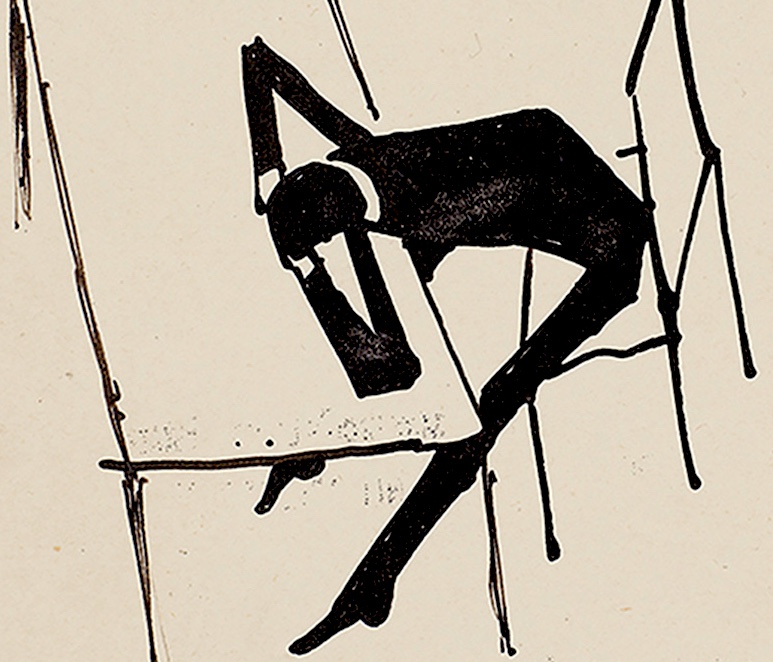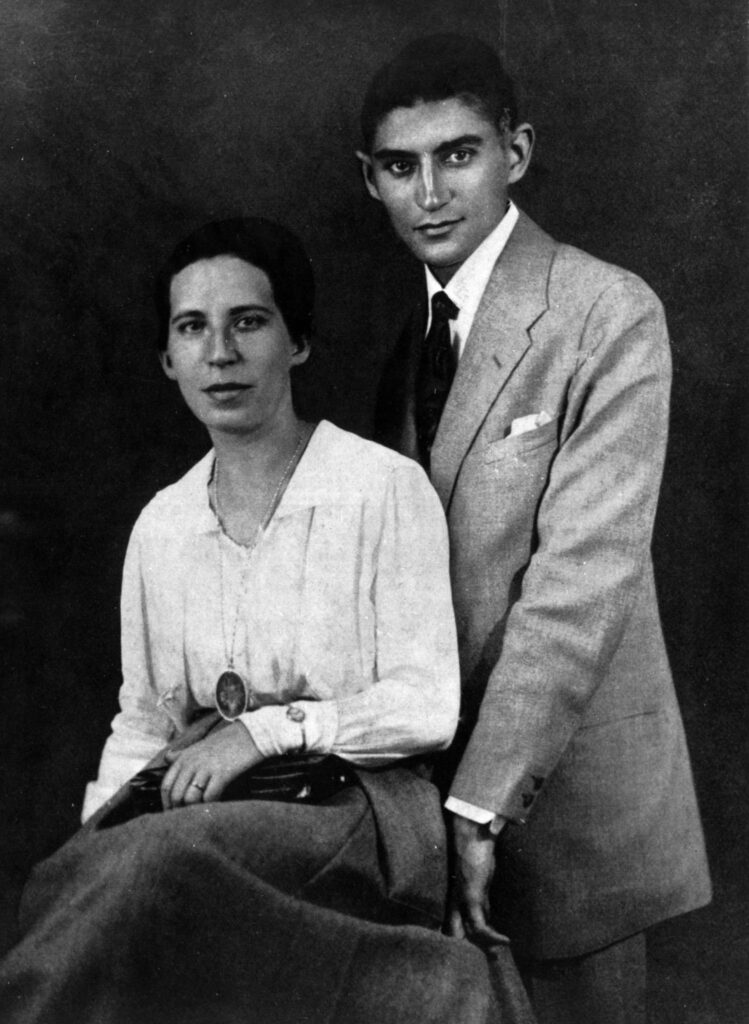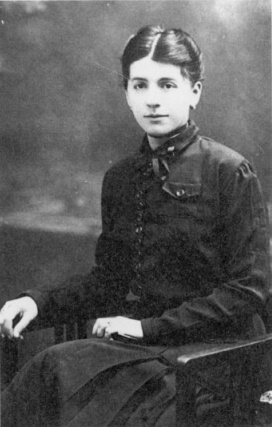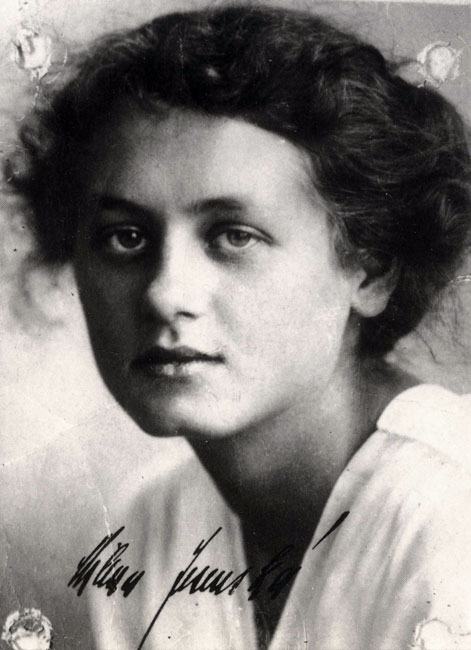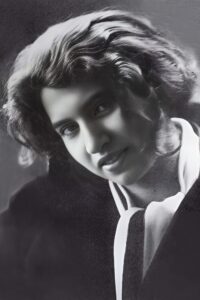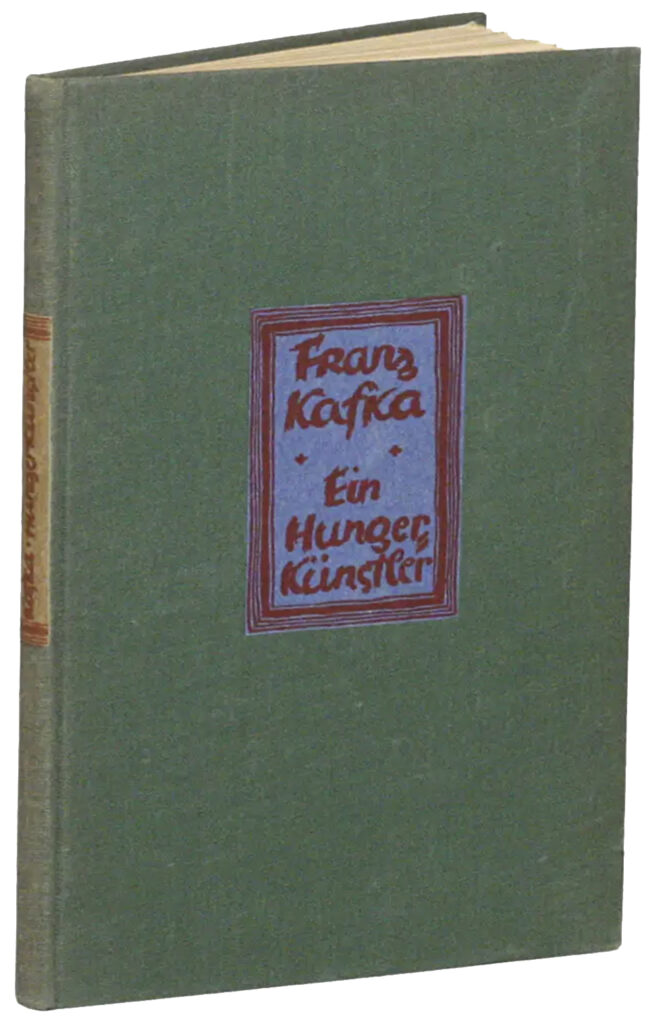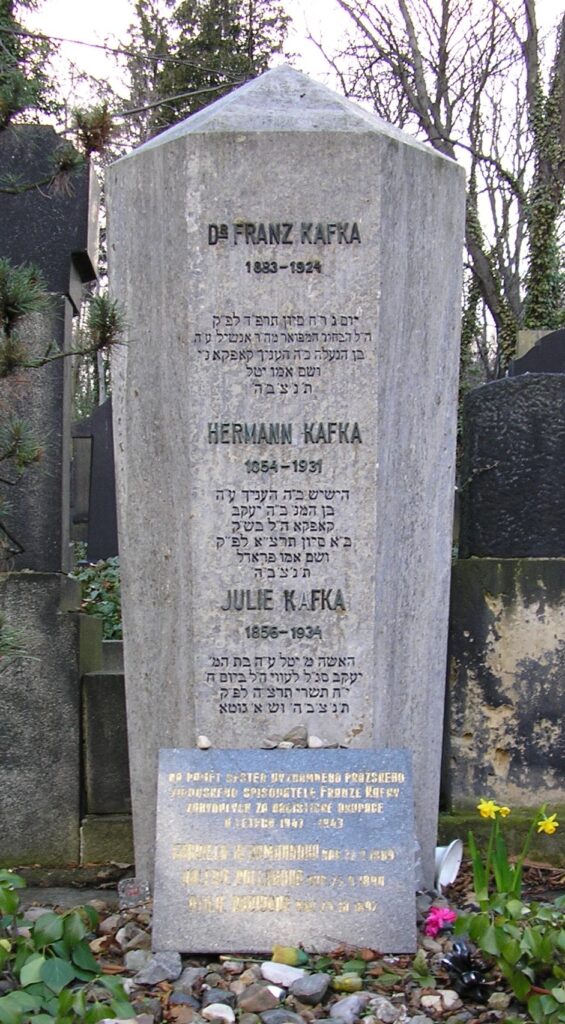Kafka Biography
- At July 04, 2024
- By Great Quail
- In Kafka
 0
0
The most fortunate and unfortunate of men
Editor’s Note: The Modern Word posted this biographical sketch off Kafka online over twenty years ago. Although our Kafka site “Das Schloss” was never finished—somewhat appropriate for its name and subject, no?—this biography circulated online for many years, whether quoted, paraphrased, plagiarized, or just indexed through the Wayback Machine. Today the Web offers a million Kafka pages, and it’s wonderful to see newer generations discovering his unique genius. Nevertheless, in honor of the centennial of Kafka’s death, we thought it would be nice to finally see this biographical sketch revised and restored.
A Little Fable
My life is a hesitation before birth.
—Diaries, 24 January 1922
Franz Kafka was born into the flux of social discord and bureaucratic dead weight that was otherwise known as Prague. With both God and father wielding hammers above his head, Kafka came of age in a city which had, under the assault of the modern world, ceased to make any sense. It was a city that had lost its own cultural identity. Burdened with administrating an empire whose lifeblood circulated in reams of paper, the crushing weight of bureaucracy belied a maze of crooked byways and dark coffeehouses, thrumming with the clash of volatile ethnicities. The contrast between the two worlds threatened with every step to cross the quiet line into absurdity. As if he had no choice, as if the metropolis clung to him madly, Kafka took it all in, made it his own, and found that he could never leave for long. He hovered around Prague all his life, and just as Joyce did with Dublin, just as Thoreau did with Concord, Kafka took his city and built for it a mythology of stories, constructed as meticulously and haphazardly as a filing cabinet of administrative documents. In the works of Franz Kafka, Prague is every city touched by brutal industrial efficiency, where humans slip quietly into the fatal gears of a vast, unreal machinery.
But if Kafka’s collected works form a private dream portrait of Prague, they also reveal a portrait of the dreamer, struggling to write his internal world into being—a mythic world, where every man working silently at an overburdened desk is stripped of identity, where the conflict between fathers and sons is enacted in Eden, and where the act of writing possesses the beautiful terror of birth. To better understand this world, we must look at the landscapes absorbed by Kafka’s creative imagination, from the dynamics of culture, community, and family to the cramped stairways over which he scurried.
As Kafka always suspected, we must begin with his father.
The Cares of a Family Man
Parents who expect gratitude from their children (there are even some who insist on it) are like usurers who gladly risk their capital if only they receive interest.
–Diaries, 12 November 1914
Hermann Kafka grew up in Wossek, a tightly-knit Jewish village roughly 50 miles south of Prague. His own father, Jakob, was the ritual butcher of the town. It was a profession which forced the family to squeak out a living, and they were unable to afford any of the luxuries that Franz would eventually enjoy. By the time Hermann was old enough to help pull a cart, he was put to work, delivering kosher meat across long distances and often in poor weather.
Perhaps as a result of this excruciating lifestyle, Hermann grew up to be a strong young man. From an early age, he knew that he wanted something better out of life. He left home at the age of fourteen, joined the army at nineteen, and in 1882, when he was thirty, he moved to the city of Prague to test his fortune. There he formed a business partnership and opened a fancy-goods shop.
In 1883 Hermann Kafka married 26-year-old Julie Löwy, the daughter of a successful brewer. Impressed with Hermann’s ambitious personality and well-built physique, Julie understood the value of hard work, and held fairly conservative attitudes regarding her role as wife. She devoted herself to her husband, keeping busy in the shop most of the day and playing cards with him during the evening. When Franz was born on July 3, 1883, he was left in the care of a nurse while Julie went back to work.
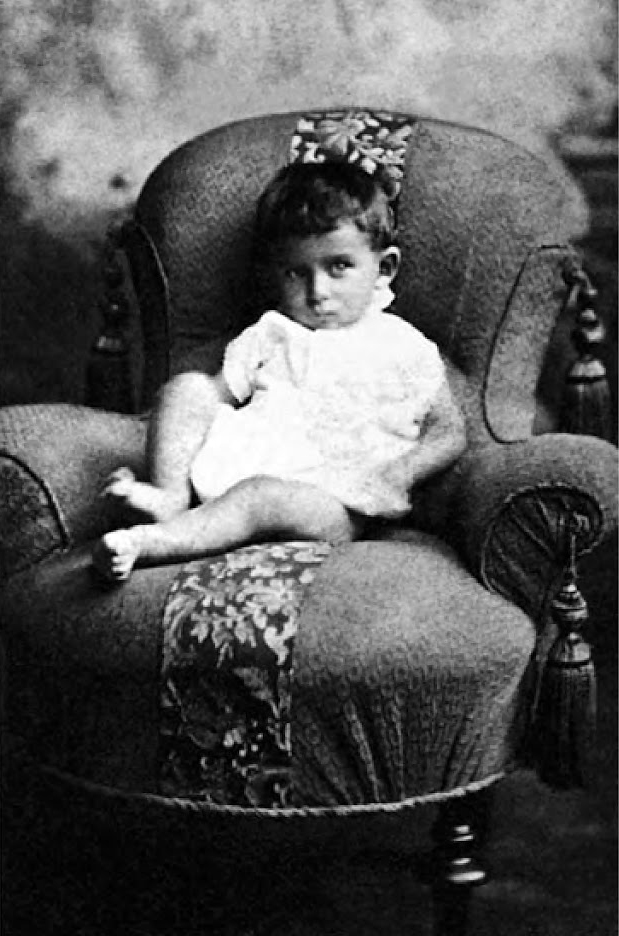 Young Franz in 1884 |
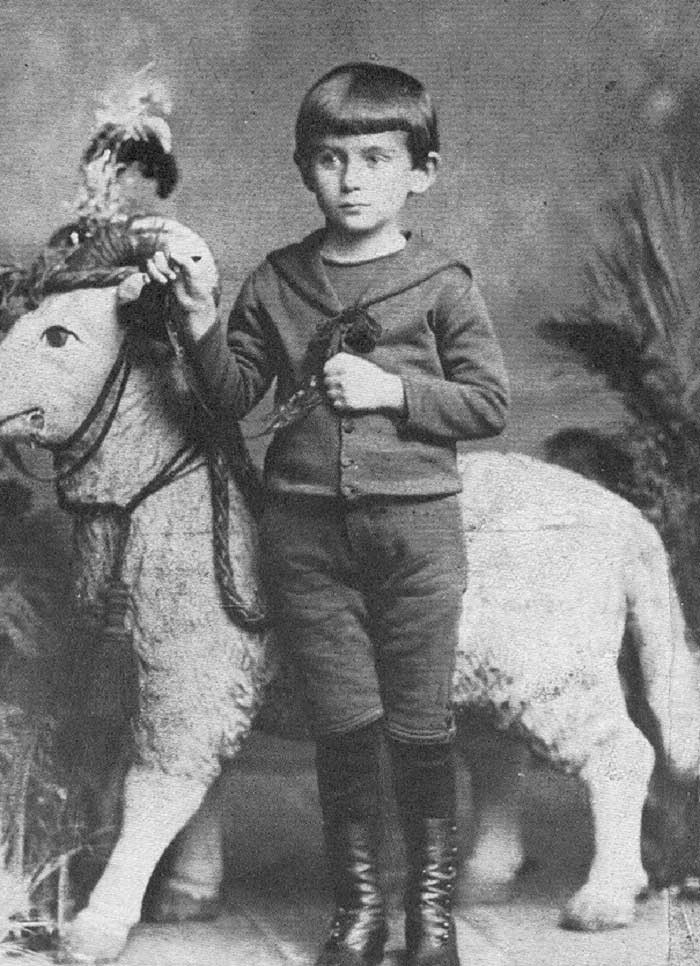 1888 |
The Tower of Babel
At the time of Franz’s birth, Prague was one of the largest cities in the slowly crumbling empire of Austria. In 1867 a compromise had been made between Austria’s Germans and Hungary’s Magyars, creating a “Dual Monarchy” divided by the Leith River. On the east side of the river was the Kingdom of Hungary, on the west the Empire of Austria. Austria was generally governed as a German nation-state, effectively alienating the large minorities which existed within its borders, including the Czechs, who were particularly angered by their exclusion. Nationalist movements arose which placed the Czech population into direct conflict with the German population. The law favored the Germans, the Czechs felt offended, and the Jews were caught somewhere in the middle.
In order to have any social mobility, a Jewish family was forced to learn German, which earned them the enmity of the Czechs. Not that this gained them much favor with the Germans, who always considered the Jews outsiders—at best. On account of this unenviable position, the Jewish community became the scapegoat for the frustrations of all the surrounding peoples. While Franz would learn German as his first language, Hermann navigated these dangerous waters by knowing both languages, the Czech of his youth and the German of the bourgeois class. (The name “Kafka” itself is a Czech word with a Germanized spelling: kavka is Czech for “jackdaw,” a bird related to ravens, rooks, and crows.) Hermann’s fluency in Czech helped him gain more customers, and allowed for clearer communications with his Slavic employees—to whom he privately referred as his “paid enemies.” On one occasion, when a riot destroyed many Jewish businesses, the mob left Hermann’s shop alone. He spoke Czech, and was therefore one of them.

“Baroque Tower House” where Kafka was born.
Photo: Petr Machan; © Goethe-Institut Czech Republic
A Common Confusion
Because Hermann’s dreams of a robust income kept him focused on his trade, Franz was often left in the care of a governess, as was common practice for the middle class. By the time he was six, two younger brothers had died in infancy, and the family had moved five times. These experiences no doubt left the young child with a sense of instability, but the family continued to grow. By 1892, Franz had three sisters—Gabriele, Valerie, and Ottilie (nicknamed Elli, Valli, and Ottla). It was this family that he would rely on for the entirety of his life.
Kafka’s deep sense of need, both financial and emotional, was often complicated by feelings of hatred—or at the very least, by the desire to escape. Indeed, most of his feelings towards his family were mixed and contradictory, and this conflict took root deep within his psyche, emerging in unexpected ways throughout his life. His father, who could certainly be overwhelming, held young Franz to higher standards than he set for himself; as a result, his son’s feelings of love and awe were tangled up with the profound sense of being a disappointment. Because his mother often took his father’s side over his, the affection he had for her was tempered by the rancor of an abandoned child. The one person in the family with whom he truly connected was his youngest sister Ottla, who was free-spirited and rebellious. He would later compare his relationship with Ottla to a “conspiracy” against their autocratic father.
Eventually, Franz enrolled in the German National and Civic Elementary School. Although he hated going to school—often needing to be dragged there by the family cook—he was a model student. After four years in the elementary school, he was admitted to the famously strict German National Humanistic Gymnasium, which represented the American equivalent of grades five through twelve. Like most schools of its time, it was designed more for indoctrination than education, as petty and unimaginative as it was pointlessly rigid. As a whole, the institution placed a tremendous focus on memorization, so much so that one of its teachers asserted that eight hours of Latin grammar each week was simply not enough. Greek was also memorized, with little discussion of content or context. One teacher introduced his students to Goethe, insisting that they model their sentences on those of the famous German writer—the idea of actually exploring what those sentences meant was naturally out of the question. And always, there was the threat of exams.
The consistent pressure transformed Kafka into a nervous wreck. After one particularly trying exam period, he succumbed to physical exhaustion, and was forced to take a long vacation to recover. Despite the fact that he performed well, he believed himself to be the dumbest student in the class, and was in constant fear of having his stupidity unmasked. He imagined that every examination would result in a tremendous failure; but in spite of this pessimism (or maybe because of it), he always passed, and sometimes even excelled. If anything, the Gymnasium taught him how to succeed despite tedium and strict regimentation, and he learned how to get by in places where he’d rather not be.
Kafka as a Student (c. 1895?)
When it came time for his bar mitzvah, the thirteen-year old Kafka approached it as just another task of memorization. His father, raised in a village defined by its Judaism, had always demanded that Franz be devout; but at the same time rarely went to synagogue himself. Religion, for Hermann, had always been a matter of concrete reality. If society saw him as a good person, then he could consider himself reasonably devout, and there was no reason to bother with those Jewish practices that made him stick out too much. Franz, having not grown up in a world where religion and life were inextricably bound, held a different view. Religion was something separate from reality, and if the rules of heaven were ever applied to earth, they would have to be followed painfully to the letter, as if one were balancing an equation. Naturally, Kafka saw his father’s ambivalence toward the synagogue as a grave hypocrisy, and from early on, he considered himself a religious skeptic. He argued with friends over the existence of God, and soon became interested in Spinoza, Nietzsche, and Darwin.
Kafka finished his studies at the Gymnasium in July 1901. In order to get into a university, he had to take the Abitur exams. Naturally, he didn’t expect to pass; naturally, he did. By November, he was registered at the German University in Prague. But once he was there, Kafka wasn’t sure what to do with himself. At first, he followed his friend Hugo Bergmann into studying chemistry, but he wasn’t very good at it, so he switched to law. It wasn’t that Kafka particularly enjoyed the subject—he compared his studies to living on “chewed-up sawdust”—but law offered a wide range of career possibilities; and as an added bonus, the longer period of study it required allowed him to stall for time. Whenever he could, he took classes in the humanities to break up the boredom. He also attended lectures sponsored by “The Hall,” a primarily Jewish student union of budding intellectuals and politicians.
Description of a Struggle
God doesn’t want me to write, but I—I must.
–Letter to Oskar Pollak
There had always been a creative bent to Kafka. A voracious reader, he had known from early childhood that he wanted to be a writer. Around the age of fourteen, he wrote plays for his sisters to perform at his parents’ birthday parties, and in 1899 he began to experiment with fiction. But writing was no way to make a living, and his father would never approve of such an impractical career choice. Furthermore, it didn’t appear that Kafka even liked anything he wrote. The only work from this period which escaped destruction is a story called “Tale of Shamefaced Lanky and Impure in Heart,” which survived only because it was included in a letter to his friend Oskar Pollak.
In 1904, Kafka began to work on a novel entitled The Child and the City, but the project was abandoned and the manuscripts lost. Pulling together again, he started “Description of a Struggle,” a piece he would revisit time and time again over the next five years.
Kafka’s earliest surviving work of substance, “Description of a Struggle” clearly reveals traces of his otherworldly and somewhat morbid imagination. Unfortunately, the story lacks the coherence needed to make its symbolism effective, and its characters and setting perform unbelievable gymnastics in the middle of an already murky plot. Realizing that he had problems with his narrative, Kafka saved portions of the story, some of which he would revise for his first publication in 1908. But for now, there seemed to be some hope for this writing thing; though not enough to dissuade him from his present course. After a brief and unproductive diversion into philosophy, he continued studying law. Then, in 1905, he showed “Description of a Struggle” to his friend, Max Brod.
The Warden of the Tomb
Kafka had first met Max Brod in October 1902. A year younger than Kafka, Brod was in many ways his complete opposite. Delicate and slightly deformed, he was nevertheless something of a ladies’ man, and radiated constant enthusiasm and boundless energy. Even as a teenager, Brod was a true polymath, and considered himself a writer, a poet, a critic, and a musician. A dynamic member of the Hall’s culture committee, he first encountered Kafka after a lecture Brod was giving on Schopenhauer. After dismissing Nietzsche as “a fraud,” the young lecturer found himself in a debate with an audience member who had quite different ideas. It was the beginning of a friendship that would last for the rest of Kafka’s short life.
Although it took Kafka two years until he finally showed Brod his own work, upon reading “Description of a Struggle,” he quickly recognized that Kafka was gifted with the spark of genius. Bringing his tireless energy to bear on his friend, Brod constantly prodded Kafka to keep writing, to stop destroying his manuscripts, and to get his work published.
It would be impossible to underestimate the importance of Max Brod in relation to Kafka’s place in literature. After Kafka’s death, it was Max Brod who gathered up everything Kafka had ever written, taking on the difficult role of editor and publisher. It was Max Brod who made sure his friend’s work survived the Nazi flames. Without Brod’s faith and perseverance, Franz Kafka may very well have vanished into obscurity, no more famous today than his friends Oskar Pollak, Franz Werfel, Felix Weltsch—or Max Brod. (It is a self-evident and famous irony: although Brod was a more prolific and much better known writer at the time, history remembers him primarily as Franz Kafka’s biographer and literary executor.)
The Sirens
Kafka’s years as a university student saw him inaugurate more than his writing career—it was during these years that he began his lifelong ambiguous relationship with sex. In 1903, he lost his virginity to a Czech shopgirl; a rather common scenario, the shopgirl being one of many who earned a little extra through a form of unprofessional prostitution. After this, Kafka uneasily took up the habit of going to brothels, a usual preoccupation with university students at the time. There were a few more “shopgirls” and “waitresses,” and in 1905 he had an affair with an older woman while on vacation in Switzerland; although the exact level of intimacy in the affair is unknown.
As one might expect from Kafka, his sexual encounters brought conflicting emotions—the ambivalence of excitement and guilt. Sex both compelled and disgusted Kafka. He was attracted to it, because—well, because he wasn’t dead; but the physicality of the act disturbed him. He couldn’t stand bodily functions, yet the body itself had undeniably attractive qualities. It was a crisis he would never resolve, and his various relationships all brought their share of confused impulses, frustrated desires, and sexual dissatisfactions. This conflict would find its way into his writing, and one can easily identify erotically disturbed mumbles in nearly all his work.
Still, there is a tendency to over-romanticize the bleakness of Kafka’s early years, especially these first sexual encounters. While certainly neurotic, overly sensitive, and occasionally given to self-loathing, Kafka was not quite the basket case that he makes himself out to be in his own reflections. Most of his friends considered him a healthy, good-looking man of uncommon intelligence, and he even admitted to being “happy” after his experience with the shopgirl. Although Kafka’s writing is starkly pessimistic, Brod contends that he was actually an easy person to get along with, if a bit on the quiet side, and undoubtedly obsessed with a search for “purity.” While Brod perceived a tremendous sorrow lurking beneath the surface of Kafka’s sardonic smile, he preferred to speak of Kafka’s wonderful sense of humor, his truthfulness, his ability to say many things in few words, and most of all, his fascination with “the greatness of nature, the curative, health-giving, sound, firmly established, simple things.”
Before the Law
In 1906, Kafka finished his exams and became an official Doctor of the Law. After a mandatory year of unpaid work for the courts, Dr. Franz Kafka took a job at the Assicurazioni Generali, an aggressive Italian insurance company. With its meager salary, soul-crushing regulations, and thankless overtime, it was probably the worst possible place for Kafka to work, and he made his escape within a year. Calling upon the help of an old friend, he secured a job at the Workers’ Accident Insurance Institute, an organization run in part by the Austrian government.
Even though Kafka didn’t exactly enjoy his job, he was a good worker, and felt a genuine degree of sympathy for the people he represented. He often secretly took their side over the company’s, sometimes giving them tips on how to get a larger settlement. He wrote a number of reports for the Institute, which gave him the opportunity to fine-tune his prose, and his unique style occasionally peeks through even these otherwise bland compositions. Despite the fact that bureaucracy is often parodied in Kafka’s work, he was well-liked by his superiors and coworkers, and he had a good degree of responsibility. His competency was rewarded, and he earned several promotions and raises during the course of his career. He was also granted a remarkable leniency towards the number of sick leaves he required, which grew more frequent until he retired two years before his death.
His new job afforded him the time to write, and in 1908, he was published for the first time: eight short pieces compiled under the title “Meditation,” appearing in Hyperion, a bimonthly magazine edited by Brod’s associate, Franz Blei. In 1910, five additional pieces, including excerpts from “Description of a Struggle,” were published in Bohemia. Fragments of thought and images, the pieces center on a bleak city, where characters wander around streetcars or stand immobile in elevators, thinking about escape. Now and then America shows up unexpectedly as a place of strength and infinite release. Because of their vague, impressionistic nature, they earned Kafka a comparison to Robert Walser.
To assess his mood from these pieces, it seemed that Kafka wanted to get away, possibly to anywhere. But the only place to which he escaped was his writing, which was rapidly becoming both a solace and a need. Unfortunately, the ideas were not always there when he wanted them, and he still had problems finishing what he started. During a dry spell, he took up a diary to keep in practice; but the drought continued, and Kafka simply could not bring any work to completion.
In 1911, Brod convinced him to collaborate on a novel entitled Richard and Samuel, a parody in which they could poke fun at each other, Richard sharing some of Kafka’s traits and Samuel some of Brod’s. That work, too, was eventually abandoned; but still Kafka forged on. He took up the habit of working in the day and writing at night, struggling to create something he felt worthy of saving.
Concerning the Jewish Theatre
In October, Brod took Kafka to a performance of the Yiddish theater. Although he had largely ignored a similar production a year earlier, this time the performance struck a chord. It completely absorbed him: somewhere in the over-the-top antics of the plays, he found an example of Jewish culture that superseded Zionism or abstract Judaism. Here was an example of Jewish culture as it was lived, a folk culture, one which permitted artistic expression and was at the same time religious. He wrote in an October 4, 1911 diary entry:
If I wanted to explain them [a couple who performed with the troupe] to someone to whom I didn’t want to confess my ignorance, I should find that I consider them sextons, employees of the temple, notorious lazybones with whom the community has come to terms, . . . people who, precisely as a result of their being set apart, are very close to the center of the community’s life . . . people who are Jews in an especially pure form because they live only in the religion, but live in it without effort, understanding, or distress.
Kafka became good friends with one of its actors, Jischak Löwy, and developed an infatuation with an actress, Mania Tschissik—who was incidentally a married woman. His father disapproved of his friendship with Löwy; true to his small-town upbringing, he looked down on actors as being little more than wandering vagabonds. At one point Hermann compared Löwy to a dog, but this wouldn’t stop Kafka—and after all, his father looked down upon all of his friends. Kafka had discovered a vibrant religious creativity, and he wasn’t about to let it go.
Kafka brought in the new year with biographical sketches of Löwy, studies of the Yiddish theater, and pieces on Judaism. At the same time, he continued to explore themes of escape and refuge, working on a novel named The Man Who Disappeared, a work-in-progress which he frequently called his “American novel.” (Brod would later changed its title from Der Verschollene to Amerika.) It tells the tale of a young man named Karl Rossmann, who is hustled away to New York after impregnating the hired help. Karl spends the rest of the novel wandering, looking for a place to settle down. Of course, nothing ever works out for Karl, and the unfinished novel’s last scene finds him traveling to the West in hope of finding a home. If we allow ourselves to view Karl Rossmann as a projection of Kafka, we might see Kafka, through Amerika, slowly convincing himself that his dreams of flight would have to remain in his head—reality doesn’t take kindly to vague, gigantic plans. If he ever wanted a place where he could feel comfortable, a place to rest, a home, he would have to find it in his surroundings.
In August of that year, Kafka met Felice Bauer at a the home of Max Brod. An executive officer for a dictaphone company, Felice was a rather stoic and capable young woman from Berlin. After a little bit of friendly talk, they half-jokingly discussed taking a trip to Palestine together. They began exchanging letters, and soon he was obsessed, flooding Felice with streams of letters and growing unbearably anxious if she didn’t respond quickly enough. At the same time, he didn’t really care to meet her again in person, preferring to carry out the entire relationship in words. It would prove to be a telling beginning to a torturous five-year affair.
The Metamorphosis
People are sewn into their skins for life and cannot alter any of the seams, at least not with their own hands.
–Letter to Felice Bauer
Whether it was the Yiddish theater, the beginnings of Amerika, meeting Felice Bauer, or an event unrecorded and forgotten, something sparked Kafka’s imagination and fired his creative energies. On the night of September 22nd, 1912, he spent eight uninterrupted hours writing his first major story, “The Judgment.” The suddenness of its creation came as a revelation; he even compared it to giving birth. “Only in this way,” he wrote in his diary afterwards, “can writing be done, only with such coherence, with such a complete opening out of the body and the soul.” The piece marked a creative turning point. He had written a story which he could read with profound interest even a year after completing it.
In “The Judgment,” the protagonist, who is about to get married, runs into problems with his father, who is resentful for having lost control of the family business to his son. Just when the son is poised to inherit the father’s mantle, he is rebuked, and ordered to drown himself—which he does, lovingly.
Although reading the story as autobiography would be unwise, it did provide Kafka with a chance to express the despair and bitterness he was feeling at the time. His father had recently gone into the asbestos business with his brother-in-law, and Hermann had been looking more and more to Franz to help oversee the factory. Not only did this absorb much of Kafka’s free time—he still held his job at the Institute—but he loathed the place itself, and soon his father began blaming him when the business began losing money. After Brod informed Kafka’s mother that her son had been entertaining notions of suicide, Julie quietly intervened, and Kafka’s workload was diminished—but his enmity towards his father only increased.
In November, Kafka began The Metamorphosis. Written in a deadpan style that is neither allegory nor exactly fantasy, The Metamorphosis features the traveling salesman Gregor Samsa, who wakes up one morning to find himself transformed into a giant bug. Discovering that his family has some trouble handling this new lifestyle, Gregor spends his time variously lost in thought, fretting about his existence, or feeling guilty about the burden he places on his family. Even though Kafka consistently disparaged his story with comments like, “I am now reading The Metamorphosis and find it bad,” and “Unreadable ending. Imperfect almost to its very marrow,” it is now regarded as a cornerstone in the foundation of modern literature.
Both “The Judgment” and The Metamorphosis contain reflections of Kafka’s recent experiences. Their characters perform the exaggerated gestures of an overdramatic play. Small religious references reveal wavering opinions about Christianity and Judaism—crosses and apples abound. There is a constant struggle with family, religion, and the workplace. The possibility—or threat—of marriage looms. The stories may be read as representative of the tensions between the business and artistic lifetsyles: could Bendemann’s friend in Russia represent Kafka as writer? Could Samsa the bug be the artist who had always been disguised? Although there are many ways to read these stories, it’s impossible to come to any definite conclusions—and neither did Kafka, who resisted simplistic interpretations. All that is certain is that Kafka took elements from his life, compacted them, and cast them into a prose style that is now recognized across the world.
After this inspired flurry, Kafka’s literary productivity dropped dramatically, though both “The Judgment” and “The Stoker” (the first chapter of Amerika) were published to some local acclaim. For a while, he considered publishing all three works under the revealing title of “The Sons,” but his publisher quietly let the matter drop—after all, Kafka was a relatively unknown and eccentric writer.
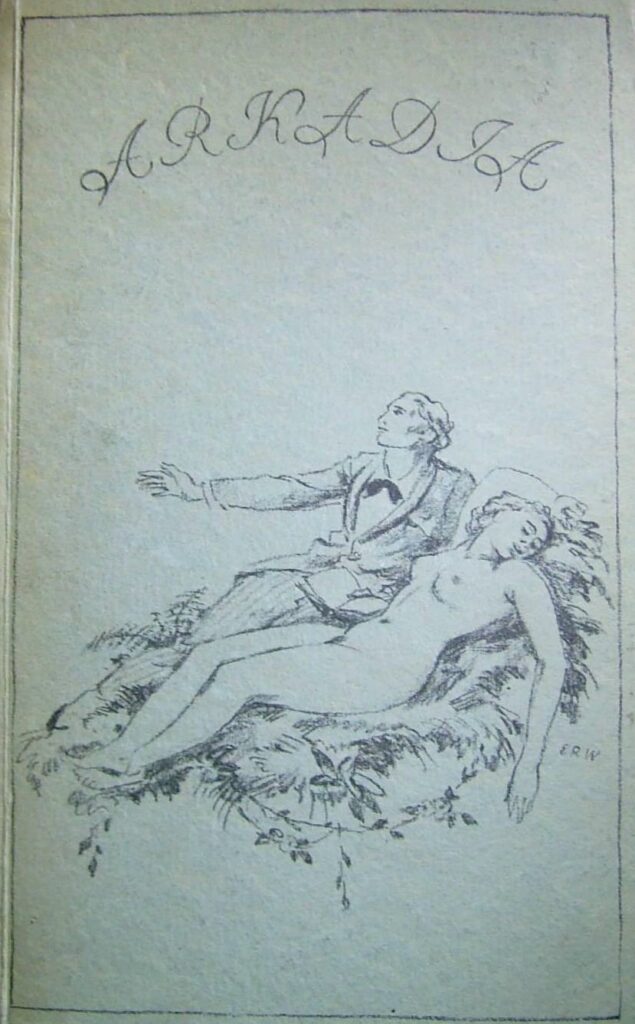
“The Judgment,” first published in Arkadia.
“I only read it for the Kafka stories!”
Give It Up!
In 1913, he twice visited Felice Bauer in Berlin; but fidelity was not in his nature—in September he had a tryst with a Swiss girl, and in November he met one of Felice’s friends, Grete Bloch. In April 1914, Franz and Felice became engaged; which didn’t stop him from carrying on an intimate correspondence with Grete. His engagement to Felice didn’t last long, and it was broken off in July of that year
On an interesting side note, after Kafka’s death, Bloch claimed that she became pregnant by him in the summer of 1914, bearing him a son who died at the age of six—all without Kafka ever finding out. Such claims, however, have come under attack by a number of biographers, and Bloch’s assertions are, at best, shaky.
Although his broken engagement with Felice was the first, it would hardly be the last. Kafka looked upon marriage as an ideal situation, something that would complete him as a human being. Realistically, however, he knew a wife would take up the time he sorely needed for writing, which he increasingly looked upon as his salvation. It is a problem that he often pondered—reasons for and against marriage are scattered throughout his diaries, sometimes even in the form of lists indexing the pros and cons. In the absence of an immediate solution, he took up the twin habits of evasion and stalling. This allowed him to dream about the possibility of marriage, while still remaining a writer in practice. He could promise engagements as much as he liked, and never have to bring his fiancée a single, absolute, sincere, “I do.”
The Problem of Our Laws
What 1914 did bring was World War I. On June 28, a Bosnian revolutionary assassinated the Archduke Francis Ferdinand, next in line to become emperor of Austria. The alliances and rivalries built up over the past decades came to a catastrophic head, and suddenly Europe was pitted against itself.
Kafka, on the whole, wasn’t that concerned; or if he was, he made a special effort to take an ironic viewpoint. His August 2 diary entry reads, “Germany has declared war on Russia—Swimming in the afternoon.” Because of his work with the government, he was exempted from military service; but a few of his relatives weren’t so lucky. When his brother-in-law returned in November, Kafka heard first-hand stories of trench warfare. Shortly thereafter, he wrote In the Penal Colony, a brutal story revolving around a complicated but efficient machine of terrifying violence. It is a work particularly suited for wartime, complete with nightmarish imagery to shock the reader and slapstick humor to stave off total desperation.
Writing this nightmarish novella helped nudge Kafka back into a more productive pattern, and he was soon spending his nights writing again. He began working on another novel, and although he would not complete it, much of The Trial was created during this period, including its beginning, its ending, and most of the sections in between.
The Trial begins with its main character, Joseph K., waking up one morning to find himself arrested by a mysterious Court. In an attempt to exonerate himself, he fights his way through a labyrinthine bureaucratic system, in part a parody of Kafka’s own insurance company. Despite its incompleteness, the novel is regarded by many to be his greatest work, and a particular passage, “Before the Law,” must only be talked about in hushed tones. A parable mixing Jewish and Chinese fables with Christian themes, the passage feels decidedly ancient in manner, yet quite modern in philosophy.
“Before the Law” was another breakthrough for Kafka, whose style soon became implanted with elements of mythology and re-tooled folk tales. This technique enabled his stories to take on the authority of history without revealing an exact meaning. It also allowed him to explore more casual manipulations of space and time, giving some stories the aspect of fairy tales, as his two main works of 1916 clearly demonstrate. In “The Hunter Gracchus,” it seems perfectly natural that a talking corpse should float into town; while the magical horses of “A Country Doctor” speed up and slow down depending on Kafka’s particular needs.
Although 1917 progressed much like the previous few years—continuous writing, the study of Hebrew, and a second engagement to Felice—in August, Kafka began coughing up blood. On September 4 he was diagnosed with tuberculosis. He obtained three weeks’ sick leave and moved in with his sister Ottla in Zürau, a country town about sixty miles northwest of Prague.
Felice and Franz in 1917
First Sorrow
Something of a hypochondriac, Kafka had always been obsessed with his uncertain health. He took many of his vacations as “rest cures” at sanatoriums, regardless of whether or not he needed any specific treatment. Expressing a cautious disdain for traditional medicine, he attached himself to the contemporary fad of nature cures; although he seemed to appreciate their positive orientation more than their actual effectiveness. He didn’t drink, he was a vegetarian for long stretches of time, he had an intolerance for noise, and he enjoyed fresh air nearly to the point of recklessness, leaving his windows open for the entire year and refusing to wear heavy clothing in winter. In spite of the meticulous attention paid to his body, his care was frequently offset by sleepless nights, devoted to writing or consumed by insomnia. In short, while his body was in generally sound condition, he was undone by some unknowable combination of unfortunate genes, eccentric habits, and simple bad luck. Using his health as an excuse, he broke off his engagement from Felice for the second time. (She got over it, marrying a little over a year later.) He also took an increasing number of sick leaves.
In 1918 he returned to his job at the Institute, continued his study of Hebrew, and took up gardening for the sake of its hard work; but he was smitten with the Spanish flu and forced to take another leave. That November, at a Schelesen boarding house for tuberculosis patients, he met Julie Wohryzek, a shy dressmaker from Prague. Finding her similar in personality to Grete Bloch, Kafka was pleased by her honesty and doting attention, and the two drifted into a romantic relationship. In a surprising about-face, he proposed marriage in the summer of 1919—against his father’s wishes, of course. Hermann considered her to be a tramp unworthy of the Kafka name, and vented his ire with full passion, suggesting that his son should simply visit a whorehouse: “If you’re afraid, I’ll make it my business to take you there myself.” Naturally stung, Kafka would later write, “I doubt if you ever verbally humiliated me more profoundly.”
Despite Kafka’s good intentions, his relationship with Julie was no threat to the family name. When the couple couldn’t keep the flat they had planned to live in, the engagement was amicably broken off; although the two maintained a rather cozy friendship for many years afterwards.
The Sons
By this time, a general armistice had been declared, and the Peace of Paris had made Prague a city of the new nation Czechoslovakia. For his own part, Kafka remained oblivious of international politics—it was family politics that weighed the heaviest on his mind. He returned to Schelesen for a two-week rest, where he spilled out “Letter to His Father.”
During the first stages of Kafka’s illness, his creative life had lapsed back into a period of idleness, his output dwindling down to aphorisms and fragments. But true to the pattern of his writing, the slump was followed by a sudden burst of energy—though this time, its focus was not fiction. Intended as an actual letter to his father, and running for a hundred or so pages, “Letter” is a tortured, almost frightening rant in which Kafka presents to his father every ruinous example of how Hermann screwed up his son’s life. Even at the age of 36, Kafka still couldn’t overcome his conflict with father and family—always wanting to break away, always driven to communicate, and still harboring the desire to start a family of his own. Fortunately for Hermann, Kafka did not possess his father’s current address, and the letter was never mailed—although he did eventually show it to his mother. (Interestingly, some biographers contend that she was perhaps its real target.)
In late November 1919, Kafka returned to the Institute. That December, A Country Doctor was published. A collection of short stories written between December 1916 and April 1917, the book was dedicated to his father, who received it with the words, “Put it on the night table.”
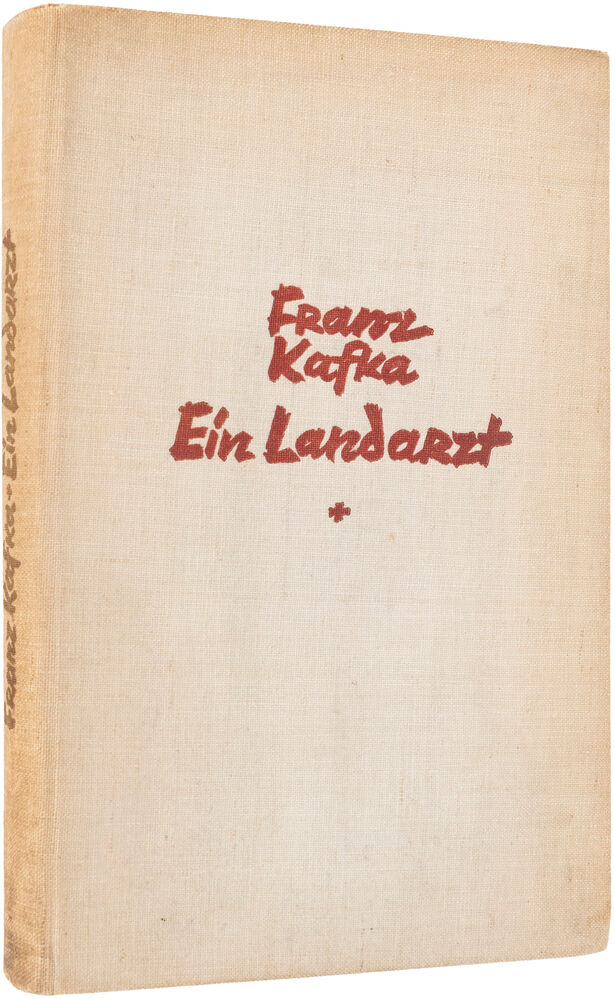 Ein Landarzt, 1919. One the first edition variants.
Ein Landarzt, 1919. One the first edition variants.
Bachelor’s Ill Luck
Although Kafka received a promotion at the beginning of 1920, his health took a turn for the worse, the disease having advanced to both lungs. In April, the Institute’s new Legal Secretary took an extended leave to Merano, Italy, to take in the famous air of its Alpine spas. While in Merano, he sent a letter to Milena Jesenská-Polak, a translator who had contacted him in the Fall of 1919, asking for permission to translate some of his works into Czech. After a faltering start, Milena began writing back, touching off a whirlwind correspondence.
In Milena, Kafka finally met his match—she was an intellectual, a true “Bohemian” in every sense of the word. Free-spirited, candid, and experimentally inclined, she existed in a state of constant rebellion with her father, a wealthy doctor with a nasty antisemitic streak. (To cure his daughter of the “illness” of dating a Jewish man, once Dr. Jesensky confined her to a lunatic asylum for nine months!) In 1918, Milena fulfilled her father’s worst nightmare and married Ernst Polak, a Jewish playboy and amateur positivist philosopher. The couple moved to Vienna, where she went from suffering her father’s abuse to suffering her husband’s: not only did Polak force her to earn her own wage through manual labor, but she remained malnourished, and developed health problems in her lungs. Additionally, as a professed believer in free love, Ernst had no qualms about seeking relationships outside of their marriage.
Milena was an enthusiastic and talented writer, and almost immediately, Kafka realized that he’d met a woman who truly shared his passion for correspondence. He opened up to Milena like he never could with Felice, and his letters to her are some of his most honest—and controversial, as he gives full expression to his frustrations as a Jew. Delighted by her translations of his work, he also respected her own writing, and even gave in to her request that he break off relations with Julie Wohryzek. For perhaps the first time in his life, Kafka was in love.
Milena was not content with keeping their relationship epistolary. As things heated up, she began pressuring Kafka to meet her in Vienna on his way home from Merano. After some prevarication, he agreed, and the two spent a delightful four days in Vienna—though they refrained from having sex. (This has led some biographers to question Kafka’s—ahem—sexual prowess; but whether his forbearance was the result of impotence or a conscious decision, Milena initially seemed understanding about his obvious sexual anxieties.) Returning home, Kafka began to exert some pressure of his own, suggesting that Milena leave her husband and move to Prague. Unfortunately, Kafka was still obsessed with marriage—a little impractical given the situation; and his letters show numerous tortuous ways for the two to be together without actually resulting in a divorce. Their letters became more strained as Milena kept finding new reasons to stay in Vienna, from her husband’s health to a renewal of her fidelity. Finally, she agreed to meet Kafka in Gmünd, a town halfway between the two capitals. It was a very unsatisfactory encounter, filled with much awkwardness and discomfort. Soon afterwards, their affair collapsed, and Kafka insisted that they stop writing to each other.
Despite this agonizing end, the two remained in each other’s thoughts, and Milena paid him several visits when he was sick in 1921. In a profound gesture of respect and goodwill, Kafka turned over his diaries to her that October. They met for the last time on May 8, 1922, when he presented Milena with the incompleted manuscript of Der Verschollene.
At Night
My life was sweeter than other people’s and my death will be more terrible by the same degree.
–Letter to Max Brod, July 5, 1922
Kafka’s health was rapidly becoming unbearable, and between the years 1920 and 1922, he took several more extended leaves, spending his time at sanatoriums, resorts, or just resting in Prague. During this time, he wrote little—creative bursts were followed by long stretches of silence. In June 1922, having tried unsuccessfully to rejoin the work force, he applied for temporary retirement from the Institute. It was granted, and he settled down to continue work on his last major project, The Castle—only to abandon it in August. A severe intestinal infection brought more misery, and his physical condition grew worse. Basically confined to his bed, Kafka renewed his interest in Hebrew, taking lessons from a young female tutor and dreaming of retirement in Palestine.
In July 1923, Kafka retreated to the seaside resort of Müritz, accompanying his sister Elli and her family. There he met the nineteen-year-old Dora Diamant, who was working as a counsellor at a nearby Jewish summer camp. Young, pretty, and full of energy, Dora had broken away from her Hasidic family in Galicia to seek her fortune in Western Europe, which was somewhat more friendly to young Jewish women interested in affairs outside the shtetl. Fluent in Hebrew and Yiddish, and possessing a nurturing, almost motherly streak, Dora proved to be the perfect companion, and within a few weeks the two were planning a future together. Despite the disapproval of both their parents—how shocking—the couple moved to Berlin, bouncing from place to place as the economy collapsed around them. Finally, Kafka had found a way to leave home.
Dora was hard set on taking care of her ailing lover, and Kafka did everything he could to remain active. Some of Kafka’s last excursions under his own power were spent attending lectures on the Talmud in the dead of winter. Living in poverty, aware at all times of his decline, the two nevertheless discussed moving to Tel Aviv, perhaps to open a restaurant.
Although Kafka managed to keep writing, it was a passion unshared by his new love. Dora felt keenly possessive about “her” Kafka, and saw his writing as “unimportant at best.” Only Dora Diamant could understand Franz Kafka, and his work was unwelcome competition for his time and attention. Indeed, unlike Max Brod, Dora did obey Kafka’s self-destructive wishes, and of the several pieces he created during his stay in Berlin, only two escaped the flames.
By the middle of 1924, Kafka’s health had reached a critical point, and he was forced to return to Prague, where he moved back in with his parents. There, with a sharp pain in his throat, he wrote his last piece—“Josephine the Mouse Singer.” A few weeks later, Dora arrived and took him to a sanatorium, where he was diagnosed with advanced tuberculosis. The pain in his throat was caused by tubercular lesions—his last months would pass in excruciating agony every time he swallowed. Settling on a sanatorium near Vienna, the couple enlisted the help of Dr. Robert Klopstock, a warm-hearted but eccentric man Kafka had befriended at a previous sanatorium. In the hope that he’d improve, he made a special point of carrying out each and every one of the doctors’ instructions, but his throat remained a constant source of misery. Kafka soon found himself parched and slowly wasting away of starvation. Communicating through the use of notes, he set about correcting the galleys of his next publication: A Hunger Artist.
Although produced in on-and-off spurts, Kafka’s last works strike a tone of deep introspection, many wondering sadly but patiently on the prospect of death, the condition of exile, the role of community, and the search for meaning before all chances are lost. If his earlier works explore the relationship between fathers and sons, many of these later pieces meditate on the relationship between the artist and society, and numerous critics have remarked upon their characteristically Jewish themes of exile and the quest for cultural identity.
His third and final unfinished novel, The Castle, follows the struggle of a man called “K.” in his attempt to join a village community. An outsider, K. repeatedly tries to infiltrate the Castle which appears to govern the town, but meets with constant frustration. He carries out cryptic, extended dialogues with the townspeople and Castle officials, making his situation more complicated and hopeless—until the novel simply stops in the middle of a sentence.
The story “A Hunger Artist,” which provides the name for Kafka’s final collection, features a man who starves himself as a form of public entertainment. With one disturbing metaphor, Kafka seems to comment on his wasting illness, his ascetic impulses, and his self-image as an artist. One of his last long narratives, “The Burrow,” was written in Berlin during one extended sitting. It is told from the perspective of a mole-like animal who has built a massive home in the ground, and spends most of his time worrying about its (and his) possible destruction. His final story, “Josephine the Mouse Singer,” is set among a community of mice. A trembling race lost in a hostile world, they seem to both worship and loathe Josephine, who is after all not really capable of song, but just a piping like any other mouse.
Other than a long letter to his parents shortly before his death, Kafka wrote nothing after “Josephine.” But still, he exhibited a surprising amount of optimism about his future; an optimism that was encouraged by Dora, Dr. Klopstock, and the visiting Max Brod. As if to make up for lost time, Kafka made plans to marry Dora. Writing her father for permission, he admitted that he had never been an Orthodox Jew; but insisted that he was returning to the faith. The answer was a blunt “No.”
That night, Dora saw an owl perched upon Kafka’s window—the bird of both wisdom and death. From then on, it was a steady decline, with daily doses of alcohol injected straight into the laryngeal nerve. Kafka wouldn’t stop asking the doctors for morphine, at one point demanding of Klopstock, “Kill me, or else you are a murderer.” At another time, he tore off his ice pack, and flinging it across the room with all his remaining strength, he groaned, “Don’t torture me any more, why prolong the agony?”
On noon, June 3, 1924, Franz Kafka died at the age of forty. At his funeral, Dora collapsed on the grave crying, while Hermann turned his back to the scene. Within ten years, both his father and mother would be buried in the same grave.
The Refusal
Max Brod was left as Kafka’s literary executor, in the possession of a letter asking him to burn anything “in the way of diaries, manuscripts, letters (my own and others’), sketches, and so on,” which included anything he could get from anybody else. “Letters which they do not want to hand over to you,” Kafka wrote, “they should at least promise faithfully to burn themselves.” The only works to be exempted were “The Judgment,” “The Stoker,” In The Penal Colony, The Metamorphosis, A Country Doctor, and “A Hunger Artist.” Everything else was to be consigned to the flames.
Naturally, Brod took the exact opposite course of action, publishing nearly everything he could find. He justified his actions based on a conversation he had with Kafka three years prior to this, in which his friend had made a similar request. Brod had responded, “If you seriously think me capable of such a thing, let me tell you here and now that I shall not carry out your wishes.” Although some rather pedantic critics have faulted Brod for publishing against his friend’s will, most agree that Kafka’s request was a clear case of deliberately leaving the fox in charge of the henhouse. It might also be noted that Brod’s critics seem to have few problems actually reading the work he saved from the flames!
Whether justifiable or not, Brod’s disobedience has given us access to a treasury of Kafka’s work: a mountain of notebooks and diary entries, stories both finished and incomplete, three unfinished novels, and some delightfully bizarre drawings that he scribbled in his margins. It is said that Brod saved Kafka’s work twice: once, from Kafka’s own judgment; and again, from the hands of the Nazis, who would have preferred to have had the works burnt and never again seen.
Departures
The world Kafka knew only survived him by a decade. His family and friends were left to make sense of a world that exceeded even his worst nightmares. All three of Kafka’s sisters died in concentration camps, as did Milena Jesenská-Polak. Grete Bloch died at the hands of a Nazi soldier. Dora Diamant died in London in 1952, and Felice Bauer in 1960. Max Brod, after ensuring that his friend’s works would outlast and outshine his own, died in Tel Aviv in 1968.
The Judgment
Accused men are always the most attractive.
–The Trial
Although at the time of his death Kafka was unknown outside of Prague, over the years his works and fame have spread far and wide. His influence on modern literature is so pervasive that it is nearly impossible to trace—Kafka has become part of the very texture of modern writing, and he practically owns the letter “K.” A German-speaking Jew from Prague, a lawyer who died young and loathed most everything he wrote, his work has been absorbed by nearly every culture across the globe, inspiring writers as diverse as Jorge Luis Borges in Argentina, Alain Robbe-Grillet in France, William S. Burroughs in the United States, Victor Pelevin in Russia, Kobo Abé in Japan, José Saramago in Portugal, Gabriel García Márquez in Colombia…the list goes on.
Kafka’s success may be measured by his presence in popular culture as well. Almost every student knows the story of the guy who turns into a bug, and Kafka is one of the few writers to be truly a “household name.” Indeed, he has become the embarrassed father of the word “Kafkaesque.” It’s a strange adjective, one supposed to express the feeling that something in our great mechanical city is simply not right. In the curvature of the letters we find a labyrinthine line of desks, where the sacred names of people are stamped, shoved into drawers, and forgotten. Somewhere, maybe behind the word or above it, is a distant law telling us that this isn’t the way things should be; but we, unfortunately, are stuck in the middle of it, perhaps between the a and the e, wondering where we’re to go and laughing at our situation—just to be able to laugh at something.
What makes matters even more hopeless is that “Kafkaesque” is so overused, it’s become a cliché to talk about how the word “Kafkaesque” is a cliché. When, in Raiders of the Lost Ark, the Ark of the Covenant gets “filed” in a warehouse in Washington DC, we can make ourselves look smart by turning to each other and saying, “Hmmm, very Kafkaesque.” And when we find out that the men in black in The Matrix are machines dressed up like pale CIA desk-jockeys, we can dance in circles and sing, “It’s just like Kaaaaaafka….” When we get lost in a maze of tax forms, read about the latest dictator executing people who haven’t done a thing, or just wake up feeling guilty and paranoid, we can tap our copies of The Trial and mutter, “Yup, it’s all in here.” The concept has become so overdone that the word “Kafkaesque” means practically nothing—and isn’t that nothing so very Kafkaesque?
Whether we like it or not, Kafka has become an indelible part of our culture. His insecurities are what self-help books have been trying to brush beneath the carpet. His sense of humor shows us how comically mistaken we are. His spiritual quest is ours. The problems he faced in his life and illustrated in his work are the same that we must face today. In Kafka, we have the heart of our humanity beat down into a few slim volumes. It might be beneficial to find out what we’re all about.
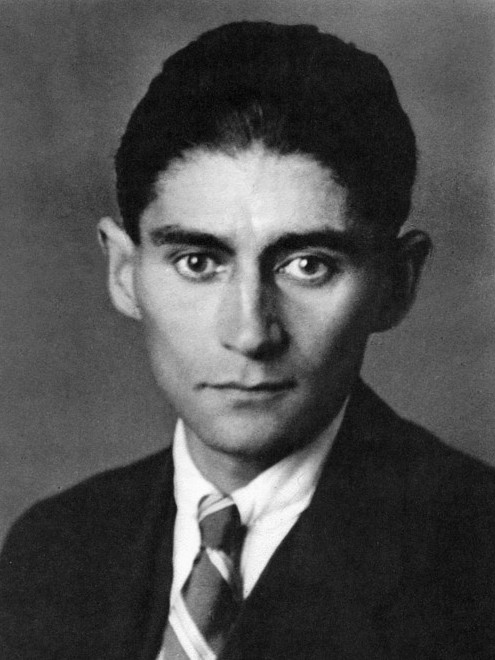 The last known photo f Kafka, 1922-23?
The last known photo f Kafka, 1922-23?
Sources and Notes
The original version of this biographical sketch was uploaded to Das Schloss in 2004. The following sources were consulted:
Bauer, Johann. Kafka and Prague. New York: Praeger Publishers, 1971.
Brod, Max. Franz Kafka: A Biography. Translated by G. Humphreys Roberts and Richard Winston. New York: Schocken Books, 1960.
Brod, Max. “Postscript to the First Edition.” Translated by E. M. Butler. The Trial by Franz Kafka. New York: Schocken Books, 1995.
Hayman, Ronald. Kafka: A Biography. New York: Oxford University Press, 1982.
Kafka, Franz. The Diaries of Franz Kafka, 1910-1923. Translated by Joseph Kresh, Martin Greenberg & Hannah Arendt. New York: Schocken Books, 1988.
Kafka, Franz. Letters to Felice. Translated by James Stern & Elisabeth Duckworth. New York: Schocken Books, 1973.
Kafka, Franz. Letters to Milena. 2nd Edition. Translated by Philip Boehm. New York: Schocken Books, 1990.
Karl, Frederick R. Franz Kafka: Representative Man. New York: Tickner and Fields, 1991.
Nahum, Glatzer N. “Chronology” and “On the Material Included in This Volume.” The Complete Stories by Franz Kafka. New York: Schocken Books, 1988.
Pawel, Ernst. The Nightmare of Reason: A Life of Franz Kafka. New York: Noonday Press, 1984.
Authors: Jeff Nowak & Allen Ruch
Original Post: 22 January 2004
Last Modified: 4 July 2024
Kafka Main Page: Das Schloss
Contact: quail (at) shipwrecklibrary (dot) com

